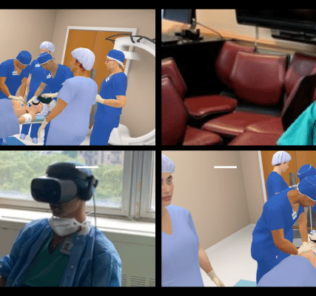TacMed’s Advanced Life Support Simulation System Goes Beyond Trauma ATLS Training
In 1998, as a family medicine resident and newly minted Advanced Cardiac Life Support instructor, I remember the endless PowerPoint slides and poor simulation tools available to teach ACLS. Pairing unrealistic-appearing manikins with limited physiology and hard-to-operate ECG rhythm generators was an impediment to learning. As Tactical Medical Solutions Senior Clinical Advisor, I work with extraordinary Tactical Medical engineers to design and improve simulation tools. I’m proud to say that with the TacMed ALS Simulation suite of products, I have had the chance to shape a simulator I would want to train with.
Probably not unlike you, for budgetary or other reasons, I have been forced to use finicky, breakable, unrealistic-appearing simulators with sim operating systems that require a computer engineering degree to run. Sometimes, not turning to a simulator at all was easier. For me, the optimal simulator looks realistic (high physical fidelity) where realism matters (high psychological fidelity) and is simply and intuitively controlled and fun to run.
This simulator is wireless and can be voiced, to limit instructor/sim operator interference in the learner’s training environment, forcing learners to gather clinical data from the “patient” and not the instructor as we do in actual healthcare. The simulator is designed with curriculum support in mind but is easy to shift simulation parameters on the fly to advance a scenario or allow for learner errors. The simulator can be used for more than just ACLS in and outside the sim center without fear of breaking. Finally, I want the learners’ experience with the simulator to be memorable in a good way, so they want to come back for more.
Sponsored Content:
The TacMed ALS 3 Component System: Not Just for Trauma
Tactical Medical Solutions (or TacMed for short) is known for trauma simulators. The first component of the TacMed ALS System is the Clinical Response Whole Body System (CRWBS). The CRWBS is uniquely designed to support ATLS training but can be detraumatized for traditional ACLS training. Made from an upper and lower torso attached at the waistline, the Clinical Response Upper-Resuscitate has wounds that can be easily covered with a sleeve or skin tone applique to take traumatic injuries out of play. Airway management is extremely realistic.
Under the chest, the simulator is designed and sponsored to allow and measure CPR effectiveness. An ultrasound-friendly right subclavian IV system supports central line training using Seldinger technique for higher-level care. A two-way communication system in the head allows learners to “talk” to the patient.
This simulator supports IV/ IO insertion, fluid administration, and BP measurement. Like the upper, the Clinical Response Lower can be detraumatized by replacing the right leg amputation with a normal leg and using provided plugs for the inguinal wound. The simulator also has interchangeable genitalia that can accept urinary catheterization. As a whole, CRWBS’s realism and feel are memorable.
Sponsored Content:
The second component of the system is the TacMed Vital Signs Monitor. The monitor wirelessly connects to the controller and reflects the “patient’s” physiology, which correlates to physical findings on the manikin. Realistic changing ECG rhythms, oxygen saturation, and other pertinent clinical data are easily seen on this ruggedized monitor which can be replaced with any commercial monitor through a VitalsBridge device.
The third component of the system is the touchscreen remote. The remote’s intuitive graphic user interface, designed to mirror actions in an ACLS code, allows sim operators to offer 12 ACLS curriculum-aligned preprogrammed Megacodes and 8 programmable Megacodes, to or adjust on the fly as needed.
As learners perform actions like applying monitors, checking pulses, securing airways, and administering medications and treatments, the sim operator and controller capture these actions generating clinically appropriate physiologic effects on monitors and physical responses on the manikin. Preset ACLS protocol-based pull-down menus and evidenced-based physiology allow the instructor to seamlessly progress through scenarios.
Designed with the ACLS instructor in mind, the TacMed controller in ACLS mode has built-in AAR checklists mirroring curriculum checklists that match the mega code being performed. This allows immediate capture of performance as the scenario progresses. A novice sim operator can master this controller in 5 to 10 minutes of familiarization and the controller is highly-ruggedized if dropped.
Error Avoidance, Error Management, and Psychological Fidelity Training
Advanced life support care is a team sport. Caring for critical patients requires good diagnostic acumen, hands-on skills, and teamwork. An ALS simulator system should allow learners to independently gather clinical information needed to make decisions and take action with the flexibility to allow for error.
The TacMed ALS system is perfect for training error avoidance, that is doing a task correctly or making the correct decision or assessment. The simulator’s high physical fidelity and airway sensors, for example, will tell users when an intubation error is made with negative respiratory physiology effects. This product is uniquely designed to also support error management training.
In error management training, learners are allowed to make errors and learn to recover from those errors (D’Angelo and Kchir). The TacMed controller allows for the wrong medications to be given and the instructor can easily create the effects on the fly. The controller also automatically corrects errors with appropriate management, such as ETCO2 normalization when accidental hyperventilation is corrected.
These little details contribute greatly to psychological fidelity, or the ability to create scenarios that trigger active problem-solving and cognitive processes that underpin deeper, longer-lasting learning (Kozlowski and DeShon). The realism also makes the learning experience extremely memorable.
Recent HealthySimulation.com TACMED Webinar:
Trauma Simulators: What is the Right Manikin Fidelity for Us?
Multiple Uses Saves Money
Simulators can be expensive. Any ALS simulator purchased today is a capital investment, especially when most simulation centers need more than one simulator. Where I think the TacMed simulator stands out is in the product’s many uses and the desire for use.
One TacMed ALS System can easily create seven different highly realistic patient presentations suitable for training in the sim center, the field, the ambulance, the ER, or the ICU. From IV catheterization to chest tubes to intubation, learners, EMS providers, nurses, advanced-level providers, and physicians can all use this capability.
While the system excels at supporting ACLS training, the product is still a great trauma trainer, and trauma is a leading cause of death in America. Sadly, no municipality or healthcare organization can afford to ignore active shooter situations in today’s world. The feedback TacMed gets from current users is that they love using the system for the system’s ease of use and learner impact as an experience they never forget.
In the end, utilization and training impact drives return on investment. What is the take-home message? The Tactical Medical Solutions ALS simulation system is not just for trauma anymore and it might be time to update your ALS simulation game.
More About Tactical Medical Solutions
TacMed Solutions was formed to develop quality, effective supplies and equipment for combat and tactical medicine. The company recognized what worked in that environment and wanted to share this understanding with as many people as possible. The company’s products reflect our experiences, situations faced and friends lost.
TacMed’s goal is to prevent others from experiencing those losses by offering equipment that allows them to operate more efficiently and effectively. Minimizing preventable death in a combat or tactical environment is a realistic and attainable goal and TacMed is proud to offer products that will help others reach this goal.
Learn more About TACMED’s Advanced Life Support Simulation System
Dr. Dan Irizarry, MD, is Tactical Medical Solutions Senior Medical Advisor. Retiring in 2018, “Dr. Dan” served 26 years in the US Army supporting medical and special operation force (SOF) organizations. Serving as the NATO SOF medical advisor, he designed and launched NATO’s first combat medical simulation center to train SOF medical personnel. In his final military assignment, he helped launch the DoD’s medical simulation acquisition and advanced development office in Orlando, FL.
Today, he helps guide TacMed’s research and development efforts to ensure medical and simulation products meet the highest clinical standards. He continues to practice family medicine as the medical director for Kanan Medical, Inc., overseeing the healthcare delivery to over 30K patients through 5 clinics in Central Florida.
Sponsored Content:
















